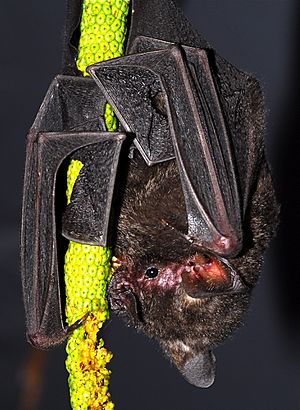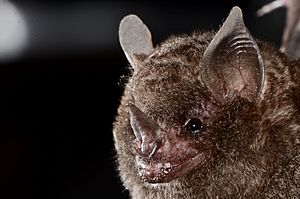Seba's short-tailed bat facts for kids
Quick facts for kids Seba's short-tailed bat |
|
|---|---|
 |
|
| A short-tailed fruit bat Carollia perspicillata feeding on a Piper aduncum fruit in a gallery forest in southeastern Brazil | |
| Conservation status | |
| Scientific classification | |
| Genus: |
Carollia
|
| Species: |
perspicillata
|
 |
|
| Seba's short-tailed bat range | |
| Synonyms | |
|
Vespertilio perspicillatus Linnaeus, 1758 |
|
The Seba's short-tailed bat (Carollia perspicillata) is a common type of bat. These bats live in many places, including Central America, the northern parts of South America, and the Antilles islands. They belong to a family of bats called Phyllostomidae.
Contents
About Seba's Short-Tailed Bat
Seba's short-tailed bats are small to medium-sized. They have short ears and a small, triangular nose. Their fur is thick and soft. It can be black, brown, or gray. Sometimes, you can even find albino (white) or orange bats in certain areas.
Males and females can be different sizes depending on where they live. In Colombia, males and females are about the same size. But in the West Indies, females are usually bigger. In most other places, males are larger.
These bats have a great sense of smell. They also see very well. While they don't rely on hearing as much as some insect-eating bats, they still use echolocation to find their way around. Echolocation means they make sounds and listen for the echoes. This helps them "see" objects in the dark. Their echolocation calls are very strong and focused. They are some of the most direct sonar beams of any bat species.
Where They Live and What They Eat
Bat Habitats and Homes
Seba's short-tailed bats are found mainly in countries like Mexico, Bolivia, Paraguay, Brazil, Trinidad, and Tobago. They prefer to live in forests, both those with trees that lose their leaves (deciduous) and those that stay green all year (evergreen).
You can often find them near calm water. They like areas with lots of open space, usually below 1,000 meters (about 3,300 feet) in height. Because of where they like to hunt for food, these bats are often caught close to the ground.
What Do These Bats Eat?
Seba's short-tailed bats love to eat many different kinds of fruit. They especially like fruits from the Piper plant family. They also eat nectar and pollen from flowers, and sometimes insects. These bats are not picky eaters. They enjoy a wide range of fruits that are high in protein and low in fiber.
When fruits are not easy to find, they eat nectar and pollen. This also means they might help pollinate the flowers they visit. This is like bees carrying pollen from one flower to another.
Bat Behavior
Roosting Habits
Seba's short-tailed bats live in groups of 10 to 100 bats. They rest, or "roost," during the day in caves, hollow trees, and tunnels. At night, they fly out to find food.
There are two main types of roosts:
- Harem roosts: These have one male bat, several female bats, and their baby bats.
- Bachelor roosts: These are for males who don't have a harem. Females might join these roosts at certain times of the year.
Male bats protect their roosts. They will often fight other males who try to enter. Before a fight, they go through a series of steps. They move their ears, lift their heads, stretch their necks, and unfold their wings. Then they might pretend to punch before actually boxing each other. Even though it's aggressive, either bat can stop fighting and leave. They usually only get minor scrapes or bruises. Males also make special sounds during these fights. These sounds might help them recognize who they are fighting. This can help them skip some of the pre-fight steps and go straight to boxing.
Bat Reproduction and Life Cycle
Male bats try to attract females to join their harems for mating. They do this by making sounds and hovering in the air. Seba's short-tailed bats have two main times of the year when they have babies. One is from June to August, when there is lots of fruit. The other is from February to May, when many flowers are blooming.
Baby bats grow inside their mothers for about 120 days. When they are born, they are quite developed and can move around well. Newborns grow quickly. They reach their full adult weight in about 10 to 13 weeks. They usually leave their parents' roost after about 16 weeks. All female bats can have babies by the time they are one year old. Males can have babies within their first two years.
Mothers talk to their babies using sounds. A mother can even tell the difference between her own baby's calls and the calls of other baby bats. When they hear their own baby's calls, mothers are more likely to go check on them. Experienced mothers are better at this than new mothers. Male bats, however, act differently. When they hear their babies' calls, they often bother the mothers until the mothers go take care of the young. The males usually don't go themselves.
How Bats Fly
Like other bats, Seba's short-tailed bats use energy efficiently when they fly. They use the most energy when flying very slowly or very fast. They use less energy when flying at moderate speeds. Most of their flights to find food are short. This is because they can carry smaller fruits back to their roosts. But they will eat bigger fruits right at the tree.
How Long Do They Live?
Seba's short-tailed bats can live for a long time, up to ten years. In their first two years of life, about 53% of bats might not survive. But after that, the survival rate gets much better, with only about 22% not surviving in later years. There doesn't seem to be a difference in how long male and female bats live.
Seba's Short-Tailed Bats in Zoos
Some zoos, like the Central Park Zoo, have colonies of these bats. They are fairly easy to breed in captivity. In fact, they are the most common bat species you can find in zoos today. At the Central Park Zoo, you can see these bats in the Tropic Zone building.
Images for kids
See also
 In Spanish: Murciélago frutero común para niños
In Spanish: Murciélago frutero común para niños




